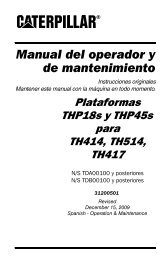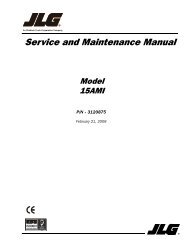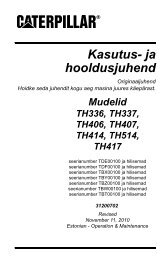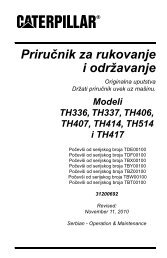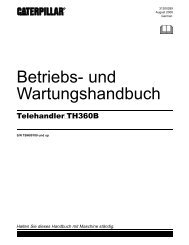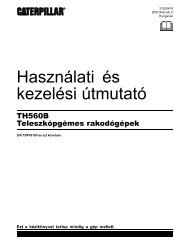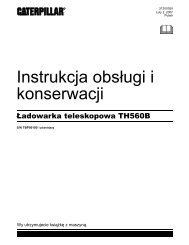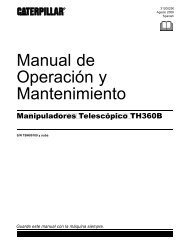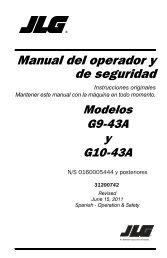Operation and Maintenance Manual
Engine - JLG
Engine - JLG
- No tags were found...
You also want an ePaper? Increase the reach of your titles
YUMPU automatically turns print PDFs into web optimized ePapers that Google loves.
42 SEBU8180-01<br />
<strong>Operation</strong> Section<br />
Engine Starting<br />
Engine Starting<br />
Before Starting Engine<br />
SMCS Code: 1000; 1400; 1450<br />
i02837427<br />
Perform the required daily maintenance <strong>and</strong> other<br />
periodic maintenance before the engine is started.<br />
Inspect the engine compartment. This inspection can<br />
help prevent major repairs at a later date. Refer to the<br />
<strong>Operation</strong> <strong>and</strong> <strong>Maintenance</strong> <strong>Manual</strong>, “<strong>Maintenance</strong><br />
Interval Schedule” for more information.<br />
• Ensure that the engine has an adequate fuel<br />
supply.<br />
• Open the fuel supply valve (if equipped).<br />
NOTICE<br />
All valves in the fuel return line must be open before<br />
<strong>and</strong> during engine operation to help prevent high fuel<br />
pressure. High fuel pressure may cause filter housing<br />
failure or other damage.<br />
If the engine has not been started for several weeks,<br />
fuel may have drained from the fuel system. Air<br />
may have entered the filter housing. Also, when fuel<br />
filters have been changed, some air pockets will be<br />
trapped in the engine. In these instances, prime the<br />
fuel system. Refer to the <strong>Operation</strong> <strong>and</strong> <strong>Maintenance</strong><br />
<strong>Manual</strong>, “Fuel System - Prime” for more information<br />
on priming the fuel system.<br />
Engine exhaust contains products of combustion<br />
which may be harmful to your health. Always start<br />
<strong>and</strong> operate the engine in a well ventilated area<br />
<strong>and</strong>, if in an enclosed area, vent the exhaust to the<br />
outside.<br />
• Do not start the engine or move any of the controls<br />
if there is a “DO NOT OPERATE” warning tag or<br />
similar warning tag attached to the start switch or<br />
to the controls.<br />
Starting the Engine<br />
SMCS Code: 1000; 1450<br />
i02322203<br />
Note: Do not adjust the engine speed control during<br />
start-up. The electronic control module (ECM) will<br />
control the engine speed during start-up.<br />
Starting the Engine<br />
1. Disengage any equipment that is driven by the<br />
engine.<br />
2. Turn the keyswitch to the RUN position. Leave the<br />
keyswitchintheRUNpositionuntilthewarning<br />
light for the glow plugs is extinguished.<br />
3. When the warning light for the glow plugs is<br />
extinguished turnthekeyswitchtotheSTART<br />
position in order to engage the electric starting<br />
motor <strong>and</strong> crank the engine.<br />
Note: The operating period of the warning light for<br />
the glow plugs will change due to the temperature<br />
of the engine.<br />
NOTICE<br />
Do not engage the starting motor when flywheel is<br />
turning. Do not start the engine under load.<br />
If the engine fails to start within 30 seconds, release<br />
the starter switch or button <strong>and</strong> wait two minutes to<br />
allow the starting motor to cool before attempting to<br />
start the engine again.<br />
4. Allow the keyswitch to return to the RUN position<br />
after the engine starts.<br />
5. Repeat step 2 through step 4 if the engine fails<br />
to start.<br />
Cold Weather Starting<br />
i02325155<br />
SMCS Code: 1000; 1250; 1450; 1453; 1456; 1900<br />
• Reset all of the shutoffs or alarm components.<br />
• Ensure that any driven equipment has been<br />
disengaged. Minimize electrical loads or remove<br />
any electrical loads.<br />
Do not use aerosol types of starting aids such as<br />
ether. Such use could result in an explosion <strong>and</strong><br />
personal injury.<br />
Startability will be improved at temperatures below<br />
−18 °C (0 °F) from the use of a jacket water heater<br />
or extra battery capacity.



